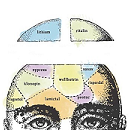
College has always been a time of major transition in young people’s lives—a unique opportunity to develop one’s individual identity while exploring interests, beliefs, and relationships. Inevitably, some have always struggled to adjust to their new independence. However, while the challenges of starting life away from home are nothing new, college student distress has risen rapidly over the years, and with this, a widespread cultural shift has occurred in how we think about such distress.
Students are increasingly encouraged to interpret themselves through a medical lens, defining their problems as symptoms of official diagnoses while treating them with psychotropic medication or therapy. For example, a 2023 study reported that 46 percent of college students had been diagnosed with a psychiatric disorder at some point in their lives, while a 2017 study found that use of psychiatric treatment had nearly doubled in college students since 2007, rising from 19 to 34 percent.
In a previous story, I reported on the “TikTokification” of mental health—a phenomenon where social media content encourages young people to self-diagnose. College students described the pervasiveness of psychiatric labels in their everyday lives, which creates an urge to embrace them as identity markers and redefine everyday challenges as illness.
But what effects do these labels have on those who are truly struggling? How does defining suffering through a biomedical lens influence not just students’ self-understanding but also their ability to feel better?
Many students find comfort in the medical model of mental health because it simplifies experiences that are otherwise messy, uncomfortable, and difficult to make sense of. “I find it really helpful to have a name for things,” says Lucy, a senior at Sarah Lawrence College, who appreciates the way diagnostic labels help her communicate with her therapist and her family. Even so, Lucy and many of her peers also feel that the medical model can become too simple, framing important aspects of their mental suffering as irrelevant. “Research is really useful for a lot of things,” Lucy explains, “but when you look at it, you don’t see the human experience.”
In conversations with college students and recent graduates from across the country and around the world, they described feeling dismissed by views of mental health that narrow their experiences to individual medical problems. When students are forced to rely on “band-aid” treatments that don’t address the root causes of their distress, the impact of larger structural factors is overlooked—and sometimes even perpetuated.
“Quick fixes”
A recent college graduate, who has asked to remain anonymous, is concerned by the prevalence of psychiatric medications on her college’s campus. She doesn’t mean this as a judgment of her peers—rather, the observation comes from her own experience taking medication for anxiety.
“[It] made me feel really weird,” she says, adding that she only stayed on it for a few months before choosing to stop. “I felt way better after I started focusing on diet, exercise, sleep, all those things,” she adds. After “getting those routines down” and building her stress management skills, her anxiety began to diminish, which had never happened with medication.
“I don’t think taking pills is always the answer,” she says. While she believes it can be helpful for some people, she wishes it hadn’t been used as a “first line of defense” when she started to struggle. After all, the drug kept her from recognizing the lifestyle factors influencing her anxiety—and also carried a risk of side effects that she feels many of her peers are unaware of.
“[Medication] is being pushed to teenagers and younger kids who can’t really advocate for themselves and aren’t encouraged to seek out information for themselves,” she explains. “I don’t think a lot of people even notice the side effects because they’re not keeping track of them.”
Instead, many of her peers rely on this “quick fix” with an unquestioning attitude the graduate finds worrying. She recalls how, when she first started taking the anxiety drug, her friends asked her which pill she was on—comparing this to their own medications in a way that felt eerily casual.
“We’re sharing which mood regulator drugs we’re on,” she says. “Something about that just feels kind of dystopian.”
Mental health conditions like depression and anxiety have been linked to lifestyle factors like sleep disturbances, diet-related inflammation, and lack of physical activity that may go overlooked when medication is prescribed at the first sign of distress. For students with milder mental health issues, focusing on these factors first would avoid the side effects—and address the root of the problem rather than temporarily alleviating the symptoms.
And while information about how personal habits can benefit mental health is prevalent online, it tends to reach students in the form of social media trends that advertise lifestyle practices as if they were products. Amy, a college student from the UK, often sees content promoting the “hot girl walk,” where users film themselves taking a walk and thinking about topics like their goals and what they’re grateful for. This trend, which began in 2020, has evolved into a trademarked wellness company that hosts events and sells merchandise while partnering with popular fitness brands.
In Amy’s opinion, the trend is now more about selling viewers a desirable image and encouraging them to “buy their way” into happiness than actually informing them about the benefits of walking outdoors. “I really understand the appeal of, like, ‘I’ll buy cute workout clothes, AirPods, new running shoes… and then I’ll start going to the gym, going on walks,’” Amy says. After all, she recognizes the pull of being distracted from the complicated real-life situations impacting your mental health.
Still, personal habits and self-care can only go so far. “You reach a point of limited marginal return,” notes the graduate from earlier. “Maybe buying one face mask is going to make you feel good, but having these consistent self-care purchases is not going to be good for you.”
This is especially true if someone’s distress is rooted in their circumstances. “We’re encouraged to treat all our problems as if they’re problems with us individually that we can solve with individual solutions,” says Amy. “Actually, there are real, material reasons why things are bad in the world, and that really contributes to mental health problems.”
In this way, trends like the “hot girl walk,” which promotes gratitude as a path to well-being, may actually be encouraging viewers to overlook the real issues that affect them—making them harder to address.
“An interesting disconnect”
Few of the students I spoke to attribute their mental health primarily to themselves. More often, they mention external issues that can’t be targeted with medication and self-care.
For example, when asked about the mental health concerns she hears students discussing on campus, Adriana Adame, a junior at the University of Texas at Austin, lists not diagnoses but life circumstances that make college students’ lives more difficult—among these, “students that don’t fit gender-conforming identity, students in minority groups, students that are not English-speaking,” and those studying “emotionally taxing” subjects.
Adame, along with many others, also believes academic stress is one of the main contributors to mental health issues in college students. “[Students] overwork themselves and take on more than they can handle,” she explains.
“I hardly get time for myself,” adds Harsh Vardhan Shaw, a student at Kalyani Government Engineering College in India. “I get so tired that I just sleep. I cannot do anything.” He used to find an outlet in activities like writing, but now school consumes his mental energy and leaves him unable to find a release.
The high tuition at many colleges can exacerbate this existing stress. Students mention that it’s common for their peers to struggle with their mental health because they’re balancing a job with a heavy academic load. This is backed by research—one 2021 study found that 70 percent of students who described their financial situation as “always stressful” met the criteria for a mental health problem, a number that fell to only 37 percent among those who described their situation as “never stressful.”
It may seem obvious that those with more stressful situations would have more mental health issues, but medical framings of mental health often characterize real-world circumstances as secondary or unimportant, locating suffering within the individual. “It puts the way you’re handling things on a very linear medical track,” notes Veronica, a recent Sarah Lawrence graduate.

Relying on this reductive definition of mental health can lead even those attempting to be supportive to miss how their own actions influence others’ wellbeing. On college campuses, for example, individual instructors and administrative protocols may emphasize the importance of student mental health in the abstract or in relation to self-care—while downplaying the ways they exacerbate it.
Finn O’Sullivan, a recent graduate of the University of Colorado Denver, describes taking a music performance class where she was initially excited about how openly her professor talked about mental health. When it came time for students to perform, though, she remembers the professor making negative comments about students who hesitated to volunteer first.
“Some people really struggle with performance anxiety,” says O’Sullivan, adding that knowing when she’ll be performing ahead of time helps her manage her own anxiety. “In the lectures that professor would give, they would talk about mental health and how that can really affect somebody. So it was just an interesting disconnect there.”
Amy has noticed similar patterns at her university, where conversations about mental health often focus on individual wellness practices, rarely acknowledging the structural factors impacting students. “It’s much easier for them to say, ‘Make sure you’re eating, make sure you’re going for walks,’” she notes, adding that there are changes the university could make to actually help students who are struggling.
“The way our timetabling is set up is really stressful for disabled students,” she says as an example. “We only have a ten-minute window to get from one class to another, and when our campus is so spread out, it’s very hard to navigate between different buildings.”
Adame, meanwhile, has had positive experiences at her school’s counseling center but feels that some of the university’s other mental health initiatives come across as “performative” and ignore the role the school plays in student mental health. For example, Adame refers to the school’s handling of pro-Palestinian protests on campus this past spring, which Adame describes as “overly forceful.”
“It was very violent,” she says. “I saw a lot of students that were angry… And this was happening during finals, so I know a lot of people that didn’t even finish the semester.” Through this, the school continued sending out texts as part of a helpline intended to support student mental health. These typically encouraged wellness practices, like taking a break from studying, that framed mental health as students’ responsibility as individuals.
“I would get [the texts] and get kind of annoyed,” Adame says. “I know they could do more to really help the students.”
“Emotional labor”
Students also recognize lack of social connection as a negative influence on their mental health. For some, this is made worse by limited free time and a scarcity of third spaces, or places to connect outside of the home and workplace. “If all you’re doing is moving between work and school and home, where do you see people?” Amy asks. “Where do you feel like you belong?”
The shift to online socializing that occurred at the beginning of the pandemic also continues to affect many students today, with virtual friendships failing to replace the in-person connections they had before. “Sometimes on video conferences, I don’t feel I’m actually talking to a person,” says Shaw. He notes that this absence of deeper friendships makes it hard to cope with his existing mental health issues by making it hard to talk about them with others. “When everything is in-person, I feel I can be open,” he explains. Now, he doesn’t “share much with anyone.”

Lucy blames trendy “pop psychology” concepts promoted by the self-help industry and on social media for the lack of close connection in her generation. For example, she often hears people talking about “emotional labor,” a term that originally referred to how certain jobs require workers to manage their emotions but has expanded to describe the unpaid emotional support given in personal relationships.
“We’ve built this very individualistic idea where you’re supposed to deal with your emotions on your own, to never burden other people,” Lucy suggests. “We’ve lost the fact that humans are very communal creatures.”
She finds that attempts to protect individual well-being end up harming relationships when people become reluctant to talk about their feelings or perform favors for their friends. “If friendships aren’t reciprocal, that’s not beneficial,” says Lucy. “But there’s some emotional labor that has to happen for friendships to actually exist.”
Students who do experience emotional closeness with their friends often find this valuable for their mental health. For example, one sophomore who prefers to remain anonymous has a routine within her group of friends where they check in with each other at least once a day to see how everyone is doing. While they tend to focus on their everyday well-being, this practice also provides a built-in source of support when someone is struggling with something more serious. “I think that’s a nice outlet to have,” the student explains, “because I can openly talk about what’s happening without it being like a therapy session.”
After all, poorer perceived social support has been linked to worse outcomes in depression and other mental health conditions—and in college students in particular, this factor has been identified as a predictor of depression symptoms. Therefore, students may be closing themselves off from important sources of support in their attempts to avoid emotional labor, unknowingly worsening their mental health despite aiming to do the opposite.
The limits of therapy
Snow, a college senior, proposes that an emphasis on therapy among her peers also makes it hard to form deeper connections with friends. “The culture is, in my experience, that you need individualized professional care,” she explains. “Your problems are your individual problems, and you need a professional to help you.”
While Snow wants to avoid creating a “burden” for others by oversharing about heavier topics, she sometimes finds it hard to talk about even mild, everyday challenges without hearing that she should speak to a professional instead. “People are sensitive about giving advice or suggestions because they know they’re not professionals,” Snow suggests, noting that, while this response may be well-intentioned, she still feels “alienated” by these dismissive interactions.
“If I share with you that I’m lonely, or recently I’ve been stressed out, or I feel kind of depressed, and you’re just going to say I need a therapist, then I’m probably not going to share that with you,” Snow says. “It’s just going to make me feel like the friendship is not the space for me to share what I’m experiencing—which makes the struggle with mental illness even more isolating.”
Many of these interactions have happened when Snow was already seeing a therapist, and she suggests that her peers overestimate the role therapy is intended to play. “People often feel like therapy is the answer for everything, and if you go to therapy you resolve all your problems,” she says—but in her experience, this is far from the truth.
Amy feels similarly, explaining that her experiences in therapy for complex post-traumatic stress disorder (C-PTSD), which stems from repeated or ongoing trauma, have shown her the limits of what can be achieved in a therapist’s office. Describing herself as a “real intellectualizer,” Amy explains that “I know what I do and why I do it… I’ve got a list, I’ve got bullet points, I’ll make you a PowerPoint. But that’s not the same thing as addressing it.”
To address it, Amy believes she must “take the insights from therapy out of the office and into my life,” acknowledging the real-world situations at the root of the issue. In Amy’s words, this is far more difficult than “sitting for hours and getting a really good grade in therapy.”
In Snow’s case, therapy sessions have frequently centered on the topic of building more fulfilling friendships. However, she can only gain so much from talking about this when the people around her remain closed-off to deeper connection, and she wishes others would recognize the futility of suggesting she solve everything in therapy.
“If you find fulfillment and happiness and joy in social connections, your mental health will be so much better,” she explains. “I think there are things that friends can do that are just as important as therapy, if not more important.”
Changing the conversation
Even when individual-focused treatments are effective, many college students struggle to access them—in fact, a 2022 study found that about 80 percent of college students reported at least one barrier to accessing mental health services. Many of these barriers are financial, and a study in 2020 found that nearly half of students at elevated suicide risk reported financial barriers preventing them from seeking help. This is particularly problematic considering that students facing economic hardship are more likely to struggle with their mental health.
College counseling services fill this gap to an extent, but many are currently overburdened by the sheer number of students seeking treatment. Some students even report that no one they know has successfully gotten an appointment. When mental suffering is increasingly framed as medical, this only leads to more demand for mental health services—and greater trouble accessing it.
Therefore, looking beyond medical treatments could be an important step forward. For example, Amy suggests that raising the minimum wage would have a major effect on the mental health of many of her peers who are struggling to pay for college. (In fact, research shows that economic interventions make a major impact. Raising the minimum wage by as little as $1 significantly decreases suicide rates among Americans with lower education levels; similarly, the 2021 expansion of the Child Tax Credit program reduced symptoms of depression and anxiety among low-income families.)
While changes like this aren’t as quick or as simple as a prescription for pills, they could have a much larger effect if implemented—and since factors like the minimum wage are usually left out of mainstream conversations about mental health, simply bringing these issues together in discussion could make a difference. It’s time to open the floor to a real dialogue with fresh ideas.

Some college students are already trying to reshape the way they talk about their distress by shifting away from biomedical language. Lucy, whose experience as a psychology student often leads her to rely on this framework, says she tries to avoid “jumping in with the scientific stuff” when someone else opens up to her about their mental health. “As much as the field of psychology is important,” she says, “you learn more from talking to people about their experience than you ever do reading an article.”
Veronica, meanwhile, describes herself as a “layman” when it comes to psychiatric terms and feels wary about applying them in her real life. “There’s a very clear limit to how much I know about that field,” she says. “My expertise is much higher on just emotionally interacting with people than trying to apply these labels.” She adds that others might also “express themselves better if they used vocabularies they had more expertise in.”
Still, Veronica recognizes that it’s easy to “lean into” this popular terminology—she’s even found herself working against the urge to use it at times. “I realized I was applying it to a lot of things without a lot of consideration,” Veronica says. “So whenever I catch myself doing that, I try to be like, ‘Is that really what’s going on? Or is that just the first word you can think of to explain the situation to yourself?’”
The simplicity of psychiatric language can make it tempting to fall back on, but narrowing our definition of mental health to the medical leaves out the social, structural, and lifestyle factors that make it difficult to cope. On college campuses and across society at large, we need to stop expecting individuals to get better on their own using medical solutions—after all, this actually worsens mental health by cutting off valuable social support and overlooking relevant societal issues. If more of us took Veronica’s approach, then, we could not only expand common conceptions of mental health beyond the individual but also create opportunities to address the real forces amplifying distress.
****
MIA Reports are supported by reader subscriptions and by a grant from Open Excellence. Please subscribe to help fund our original journalism.




Excellent article.
There once was a time when going away to college meant an opportunity to learn about oneself as much as any academic subject. But those days are long gone. It’s now become a financially backbreaking and emotionally isolating endurance contest that leaves little to no room for students to meaningfully connect with each other, much less themselves. Instead, many campuses have become the ideal place for psychiatry’s disease model to distract, pollute, and isolate vulnerable young minds, to talk them into seeing themselves as “mentally ill” simply for being human, to distract them from learning to cope successfully with difficult feelings, something that much of the time means learning to connect with oneself and others in meaningful and hopefully lasting ways. In other words, learning how to form something called “friendships”, instead of being dependent on “therapists”.
Report comment
I suspect that students will need to get used to being pathologized because of the affects of their sometimes horrific experiences, which will be reduced to the belief system, u.s. dsm, of biomedically focused doctors, nurses, psychologists, social workers, occupational therapists, etc. In the u.s., for example, children’s – normal – reactions to abnormal situations and negative experiences, like those of adults, are being routinely “addressed” by diagnosing those reactions via dsm – e.g., as bipolar, clinical depression, adhd and autism, focusing on what is (imagined to be) wrong with the person and ignoring what has happened to them. I’ve attached a webinar which looks at some of the history and consequences of pathologizing children’s experiences for anyone who worries about using dangerous drugs to control babies, toddlers and older children’s behaviours. To me psychiatric diagnosis can end up being medical child abuse, but I could be wrong…
This might also be of interest to anyone concerned about the diagnosis and medication of adults.
CFCA Webinar – Diagnosing children with mental health difficulties: Benefits, risks and complexities
https://www.youtube.com/watch?v=zBQl0VAvLPc
Report comment
This article implies the Medical Model is harmful. The Medical Model saves lives when the correct medication is given to those who have psychosis or those who have suicidal ideation. Both the Medical Model and Recovery Model are needed.
Report comment
Opinions are absolutely worthless. Why hold an opinion when you are ignorant of the facts? It is so much more intelligent to say “I don’t know”.
Report comment
The medical model that I was taught at Michigan State was the Bio-Psycho-Social Model. It is inclusive, practical, and builds compassion. And, it requires time to build relationship: something more than a 10- minute med check.
We know a lot about what helps humans. I wonder who is doing a good job in universities that we could learn from. The time is ripe!
Report comment
The so-called “medical model” only numbs peoples’ brains. I don’t call that recovery. Do you?
Report comment
“This article implies the Medical Model is harmful. The Medical Model saves lives when the correct medication is given to those who have psychosis or those who have suicidal ideation. ”
As Mad in America and other related critical psychiatry communities have pointed out, the medical model may also create psychosis, make psychosis worse, or/and make individuals suicidal.
Report comment
Thank you for this insightful article.
Report comment
My experience of the medical model is of it having taken the place of asking questions, in other words of prescribing medication for a supposed diagnosis taken from the DSM with absolutely no attempt to investigate anything about my past life. It took decades of inner work in psychotherapy – following repeated psychotic breakdowns in hospitals, to fully reach, uncover and process the true buried causes of severe depression, acute anxiety and psychosis. To totally overturn a completely false diagnosis and prognosis which stated my condition was due to a chemical imbalance in the brain, genetically inherited, no known cause, incurable, and would require medication for life. Uncovering the true causes which were extensive childhood abuse and its denial and coverup, from which I was dissociated, while being a grievous, tortuous and often mostly unbearable journey, has been my path to healing and freedom. I have had no psychiatric medication for about twenty years. I was re -diagnosed a few years ago with complex PTSD and told it should have been that in the first place and that if I had at that time been given the option of psychotherapy instead of what I was told and prescribed, I would have had a completely different life and that my original diagnosis had been for compliance and to silence me. I was told this by a consultant psychiatrist who had been assigned to me for the purpose of assisting my CICA case after I had reported my historic abuse to the police. This psychiatrist – who to my great good fortune was an expert in recognising and understanding dissociation, told me he had worked many years ago with the psychiatrist who had originally MIS-diagnosed me and which had led me down a completely wrong path.
So yes, I strongly believe the medical model is harmful.
Thank you for this excellent article.
Report comment
I understand from reading articles that when today’s students experience feeling down, debilitated, anxious, manic, panicked, obsessed, they wonder if they are just reacting to their life situation and to concerns they have about themselves or their life or, on the other hand, if they have a mental illness.
That is a false dichotomy. Those are not two different things. The states of being, moods, thoughts, intentions, feelings and behavior associated with diagnoses of mental illness are simply how people are reacting to their life situations and to concerns they have about themselves and their lives. Mental illnesses are emotional distress, life crises, difficult dilemmas, spiritual emergencies, various kinds of overwhelm and fear. That is what mental illness is. It is not alien. It doesn’t come out of the blue. It isn’t mysterious. It’s about your life. It isn’t helpful to understand mental illnesses as caused by brain disorders, chemical imbalances and genetic anomalies. That is a very disempowering belief. What are you going to do about that? We don’t have control over our brain function, biochemistry or genetic dynamics. What we call mental illnesses are how people avoid pain, protect themselves, react to feeling hopeless about their lives, feel more powerful and adequate, get the illusion of being in control, dissociate from traumatic circumstances. Since mental illnesses are how people are reacting to their life situations and to concerns they have about themselves and their lives, the way to help them is help them learn to use their thoughts, feelings, emotions, perceptions, intentions and behavior to live the way they want to live, i.e., to love the way they want to love (that includes all kinds of love – romantic love, sexual love, collegial love, familial love, friendship love) and to use their abilities in satisfying, enjoyable ways.
Report comment